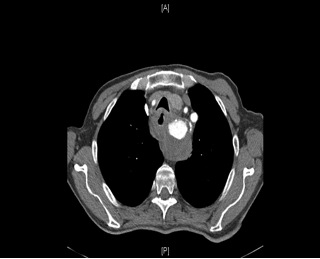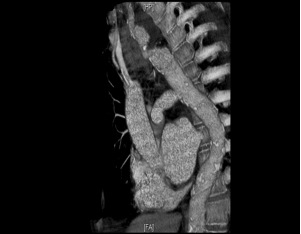Esophageal Carcinoma invading a Kommerell’s aneurysm: an unrecorded cause of inoperability
Hany Elsayed, Richard Warwick, Amir Khan, Abbas Rashid.
Liverpool Heart and Chest Hospital NHS Trust- Thomas Drive - Liverpool- L14 3PEUK
Key words: Kommerell, subclavian artery, Esophageal cancer
Aberrant right subclavian artery (ARSA) occurs as a result of abnormal regression of the fourth aortic arch and persistence of patency of the right eight dorsal aortic segment. This is a rare congenital anomaly of the aortic arch found at post-mortem examination with a frequency of 0.5%. Sixty percent of patients with ARSA have Kommerell's diverticulum and aneurysm of the diverticulum have been observed in 3–8% of these patients (1).
Most patients with ARSA are asymptomatic, but during adulthood 5% of patients with this anomaly have symptoms because the development of atherosclerosis and dilatation of Kommerell's diverticulum results in compression of the esophagus or the trachea (2).
A sixty seven year old man presents with increasing dysphagia and loss of appetite over the past three months. Dysphagia was more towards solid fluid and he notices he is more comfortable with a semi-fluid diet. Past medical history included hypertension and an abdominal aortic aneurysm which is being followed up for the past five years. He was only on anti-hypertensive medications. His social history was significant for current smoking of a thirty pack per year. Family history was irrelevant. His examination was unremarkable apart from being mildly cachetic and the presence of a pulsating abdominal mass.
An esophagoscopy is done which reveals a mass in the cervical esophagus measuring 4x4 cm. with signs of external invasion. Biopsy from the mass reveals the lesion to be a squamous cell carcinoma. A CT-scan of his chest and abdomen (Fig. 1 and 2) is done to allow staging. This revealed an extremely rare finding by showing his esophageal carcinoma to invade an aneurysm of a diverticulum arising from an aberrant right subclavian artery (so called Kommerell’s aneurysm). The tumour was considered unresectable on the basis of invasion of an unrecorded vascular structure.
The patient was started on palliative chemotherapy.

Fig (1) CT scan showing invasion of the aneurysm by the Esophageal mass.

Fig (2) Reconstructed CT-scan of the Chest clearly showing invasion of the distal part of the Kommerell’s aneurysm by the Esophageal Carcinoma.
References
1) Austin EH, Wolfe GW. Aneurysm of aberrant subclavian artery with a review of the literature. J Vasc Surg. 1985;2:571–7.
2) Van Son JAM, Konstantinov IE, Burckhard F. Kommerell and Kommerell's diverticulum. Tex Heart Inst J. 2002;29:109–12.
Copyright Priory Lodge Education Ltd 2010
First Published February 2010
All pages copyright ©Priory Lodge Education Ltd 1994-


